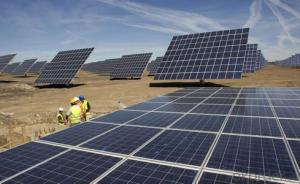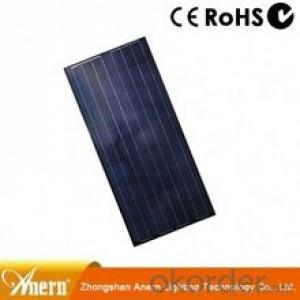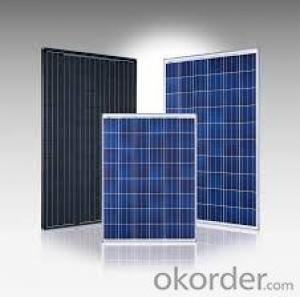Polycrystalline solar Panel of Best Price High Quality CNBM
- Loading Port:
- Qingdao
- Payment Terms:
- TT OR LC
- Min Order Qty:
- 10 set
- Supply Capability:
- 300000 set/month
OKorder Service Pledge
OKorder Financial Service
You Might Also Like
Polycrystalline Solar Modules
CNBM offers a range of small, medium and large polycrystalline solar modules, designed for a range of requirements.
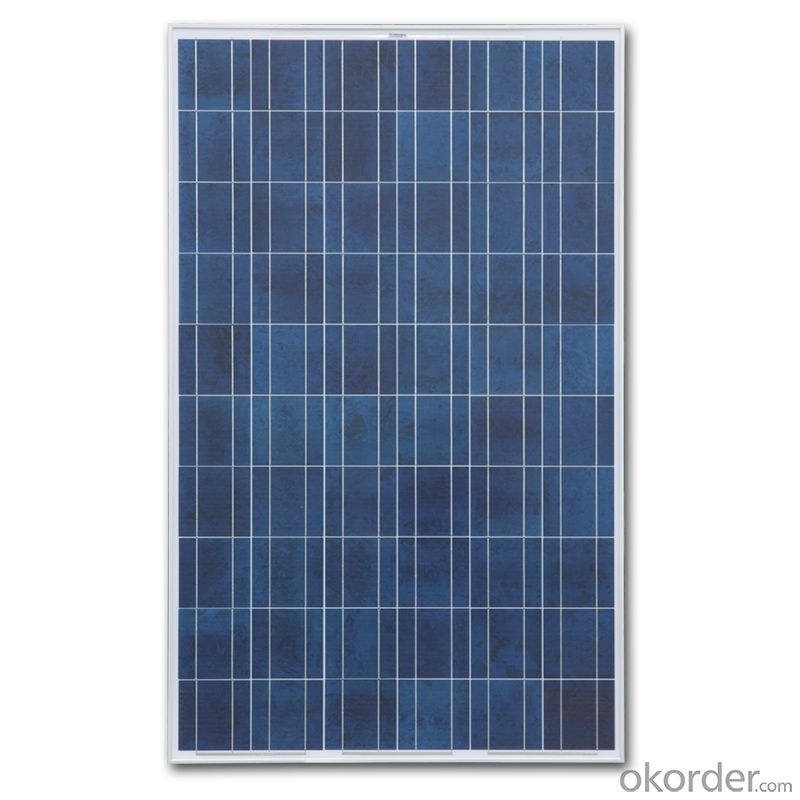
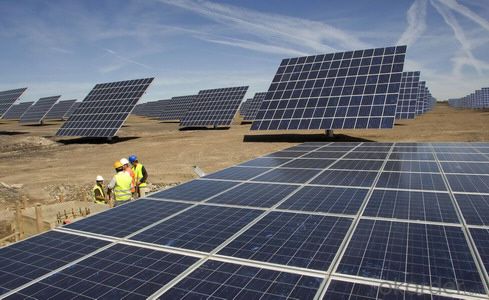
Specifications:
Tolerance | +/-3% |
Cell | Polycrystalline silicon solarcells (156 x 156mm) |
N0. of Cells | 60 (0 x 6) |
Dimension of Modules (mm) | 1650 x 990 x 40 |
Weight (kg) | 25.5 |
Limits:
Operating Temperature | -40~+85? |
Storage Temperature | -40~+85? |
Maximum System Voltage | 1000 VDC max. |
Hail Impact | Diameter of 28mm with impact speed |
Temperature and Coefficients:
NOCT | 48C+/-2? |
Voltage temperature coefficient (%/K) | -0.35 |
Current temperature coefficient (%/K) | 0.05 |
Power temperature coefficient (%/K) | -0.45 |
Characteristics:
Model: | SGM-200P | SGM-210P | SGM-220P |
Max-power voltage Vmp (V) | 29.2 | 29.4 | 29.41 |
Max-power current Imp (A) | 6.85 | 7.14 | 7.48 |
Open-circuit voltage Voc (V) | 36.5 | 36.69 | 36.9 |
Short-Circuit Current Isc (A) | 7.28 | 7.6 | 7.93 |
Max-power Pm(W) | 200 | 210 | 220 |
Model: | SGM-230P |
Max-power voltage Vmp (V) | 29.8 |
Max-power current Imp (A) | 7.72 |
Open-circuit voltage Voc (V) | 37.31 |
Short-Circuit Current Isc (A) | 8.19 |
Max-power Pm(W) | 230 |
STC: Irradiance 1000W/m2, module temperature 25?, AM-=1.5
Poly Crystalline Solar Panels Specifications Range
Maximum Power (Pm) | Dimension | Weight | Operating Voltage (Vmp) | Operating Current (Imp) | Open Circuit Voltage (Voc) | Short Circuit Current (Isc) |
0.45W | 140x80x10mm | 0.08kg | 3.3V | 150mA | 4.6V | 160mA |
1.0W | 162x140x10mm | 0.16kg | 7.5V | 150mA | 10.3V | 160mA |
4.5W | 269x251x23mm | 0.8kg | 16.5V | 0.27A | 20.5V | 0.3A |
10W | 420.1×268.9×22.6mm | 1.92kg | 17.5V | 0.58A | 20.5V | 0.6A |
20W | 425x502x50mm | 3.0kg | 16.8V | 1.19A | 21.0V | 1.29A |
30W | 593x502x22.6mm | 3.9kg | 16.8V | 1.78A | 21.0V | 1.94A |
40W | 655x537x50mm | 5.75kg | 17.3V | 2.31A | 22.1V | 2.54A |
50W | 839x537x50mm | 6.0kg | 17.5V | 2.9A | 21.8V | 3.17A |
65W | 1111x502x50mm | 7.2kg | 17.6V | 3.69A | 22.1V | 3.99A |
80W | 1204x537x50mm | 7.7kg | 17.6V | 4.55A | 22.1V | 4.8A |
- Q:How do solar cells perform in areas with high levels of air humidity?
- Solar cells generally perform less efficiently in areas with high levels of air humidity. The moisture in the air can lead to the formation of a thin layer of water droplets on the surface of the solar cells, which can block sunlight and reduce their ability to generate electricity. Additionally, high humidity can accelerate the degradation of the materials used in solar cells, potentially shortening their lifespan. Therefore, it is important to take these factors into consideration when installing solar panels in humid areas.
- Q:What is the impact of solar cells on wildlife?
- Solar cells have a minimal impact on wildlife as they do not produce any direct pollution or emissions that could harm animals. However, the installation of solar farms can disrupt natural habitats and affect local wildlife by altering the landscape and reducing available space for vegetation and animal species. Implementing proper planning and wildlife-friendly measures during the construction and operation of solar farms can help mitigate these potential impacts and create a more harmonious coexistence with wildlife.
- Q:Can solar cells be used in medical devices?
- Yes, solar cells can be used in medical devices. They can be utilized to power various medical devices such as portable ultrasound machines, defibrillators, blood glucose monitors, and even wearable devices like pacemakers. Solar cells provide a reliable and sustainable source of energy, enabling medical devices to function efficiently in remote or resource-limited areas where access to electricity may be limited.
- Q:Can solar cells be used for lighting?
- Yes, solar cells can be used for lighting. Solar cells generate electricity from sunlight and this electricity can be used to power light bulbs or other lighting devices. This allows for the use of renewable energy sources and can be particularly beneficial in remote areas or during power outages.
- Q:Can solar cells be used in powering autonomous vehicles?
- Yes, solar cells can be used to power autonomous vehicles. Solar panels can be installed on the exterior or integrated into the body of the vehicle to capture sunlight and convert it into electricity. This renewable energy source can help supplement the vehicle's power needs, extending its range and reducing its reliance on fossil fuels. Additionally, advancements in solar technology and efficiency are making it more feasible to use solar power as a primary or secondary energy source for autonomous vehicles.
- Q:Can solar cells be used underwater?
- No, solar cells cannot be used underwater as they rely on sunlight to generate electricity. Water blocks sunlight and prevents the solar cells from functioning effectively.
- Q:Can solar cells be used in powering drones?
- Yes, solar cells can be used in powering drones. Solar cells convert sunlight into electrical energy, which can be used to power various devices, including drones. By integrating solar panels onto the surface of the drone, it can harness solar energy and charge its batteries, extending its flight time and reducing the reliance on traditional power sources.
- Q:What is the impact of algae growth on solar cell performance?
- Algae growth on solar cells can significantly reduce their performance. The presence of algae creates a layer on the surface of the cells, which blocks sunlight from reaching the photovoltaic material. This reduces the efficiency of the solar cells and lowers the amount of electricity they can generate. Additionally, algae can also cause corrosion and damage to the solar cell surface, further impacting its performance and longevity. Therefore, it is crucial to regularly clean and maintain solar panels to prevent algae growth and ensure optimal energy production.
- Q:How are solar cells installed?
- Solar cells are typically installed on rooftops or open ground areas. First, the installation site is surveyed to determine the best location and angle for maximum sunlight exposure. Then, the solar panels are mounted onto a structure using brackets or frames. The panels are interconnected and wired to an inverter, which converts the direct current (DC) generated by the panels into usable alternating current (AC) electricity. Finally, the system is connected to the electrical grid or a battery storage system, allowing the generated solar energy to be used for powering homes or businesses.
- Q:How can I buy the solar cells wholesale ?
- The wholesale price for solar cell is based on your quantities of the solar cells you want to buy from the manufacturers. The more you order, the cheaper wholesale price you would get.
1. Manufacturer Overview |
|
|---|---|
| Location | |
| Year Established | |
| Annual Output Value | |
| Main Markets | |
| Company Certifications | |
2. Manufacturer Certificates |
|
|---|---|
| a) Certification Name | |
| Range | |
| Reference | |
| Validity Period | |
3. Manufacturer Capability |
|
|---|---|
| a)Trade Capacity | |
| Nearest Port | |
| Export Percentage | |
| No.of Employees in Trade Department | |
| Language Spoken: | |
| b)Factory Information | |
| Factory Size: | |
| No. of Production Lines | |
| Contract Manufacturing | |
| Product Price Range | |
Send your message to us
Polycrystalline solar Panel of Best Price High Quality CNBM
- Loading Port:
- Qingdao
- Payment Terms:
- TT OR LC
- Min Order Qty:
- 10 set
- Supply Capability:
- 300000 set/month
OKorder Service Pledge
OKorder Financial Service
Similar products
New products
Hot products
Hot Searches
Related keywords
